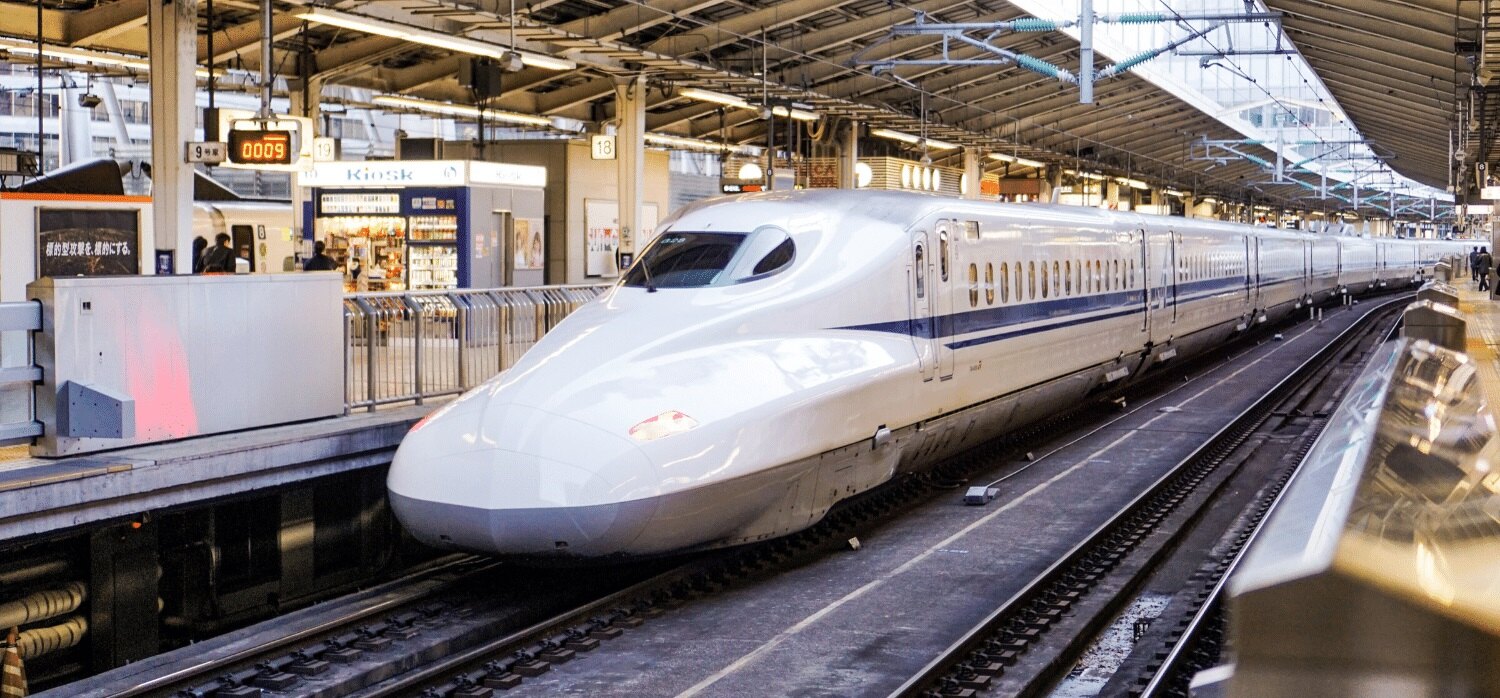
Bullet trains, also known as high-speed trains, are marvels of modern engineering and transportation. These sleek and aerodynamic trains have revolutionized travel, offering a rapid and efficient mode of transportation for millions of people worldwide. From their impressive speed to their advanced technology, bullet trains have captured the imagination of travelers and technology enthusiasts alike.
In this article, we will delve into 18 fascinating facts about bullet trains, shedding light on their history, technological innovations, and their impact on global transportation. Whether you're a train enthusiast or simply curious about these incredible machines, these facts are sure to pique your interest and deepen your appreciation for the incredible world of bullet trains.
So, buckle up and get ready to embark on a thrilling journey through the world of high-speed rail as we uncover the remarkable facts that make bullet trains a true marvel of modern transportation.
Key Takeaways:
- The bullet train, or Shinkansen, revolutionized transportation in 1964 with its incredible speed, safety, and comfort, inspiring high-speed rail projects worldwide and shaping Japan’s modern identity.
- The bullet train seamlessly blends tradition and innovation, offering passengers a smooth, efficient, and environmentally friendly travel experience while showcasing Japan’s rich cultural heritage.
The first bullet train, the Shinkansen, was launched in 1964.
The Shinkansen, also known as the "bullet train," made its debut in Japan in 1964, just in time for the Tokyo Olympics. This high-speed rail system revolutionized transportation with its unmatched speed and efficiency, setting a new standard for railway technology worldwide.
The bullet train can reach speeds of up to 320 km/h (200 mph).
With its cutting-edge technology, the bullet train can achieve remarkable speeds, allowing passengers to traverse long distances in a fraction of the time it would take using conventional trains or automobiles.
The Shinkansen network covers over 2,765 kilometers (1,717 miles) of track.
This extensive network connects various regions across Japan, providing a swift and convenient mode of travel for both domestic and international passengers.
Bullet trains prioritize punctuality, with an average delay of just 36 seconds.
The precision and reliability of bullet trains are unparalleled, ensuring that passengers can rely on reaching their destinations promptly.
The technology behind bullet trains minimizes noise and vibration.
Passengers can enjoy a smooth and quiet ride, thanks to the advanced engineering that mitigates noise and vibration, enhancing the overall travel experience.
The bullet train's aerodynamic design reduces air resistance.
Its sleek and aerodynamic structure not only contributes to its iconic appearance but also plays a crucial role in minimizing air resistance and maximizing speed.
The Shinkansen has maintained an exceptional safety record since its inception.
Despite the high speeds at which it operates, the bullet train has maintained an impeccable safety record, making it one of the safest modes of transportation globally.
The bullet train's regenerative braking system enhances energy efficiency.
Through innovative regenerative braking technology, the bullet train can convert kinetic energy into electrical power, significantly reducing energy consumption and environmental impact.
The interior of the bullet train is designed for comfort and convenience.
Passengers can enjoy spacious seating, ample legroom, and various amenities, ensuring a comfortable journey throughout their travels.
The bullet train has inspired high-speed rail projects worldwide.
The success and impact of the Shinkansen have influenced the development of high-speed rail systems in numerous countries, contributing to the advancement of global transportation infrastructure.
The bullet train has significantly reduced travel times between major cities in Japan.
By drastically shortening travel durations, the bullet train has facilitated greater connectivity and economic growth across different regions in Japan.
The Shinkansen plays a vital role in promoting sustainable transportation.
With its energy-efficient operations and minimal environmental impact, the bullet train aligns with the global push for sustainable transportation solutions.
The bullet train has become an iconic symbol of technological prowess and innovation.
Its iconic status extends beyond Japan, representing a testament to human ingenuity and engineering excellence on a global scale.
The bullet train experience extends beyond transportation, offering breathtaking scenic views.
Passengers are treated to picturesque landscapes and stunning vistas during their high-speed journey, enhancing the overall travel experience.
The bullet train's advanced infrastructure includes dedicated tracks and signaling systems.
The cutting-edge infrastructure of the bullet train ensures optimized operations and safety, setting a new standard for rail transportation infrastructure.
The bullet train has continually evolved with technological advancements.
Through ongoing research and development, the bullet train has incorporated the latest technological innovations, ensuring that it remains at the forefront of high-speed rail transportation.
The Shinkansen has played a pivotal role in shaping Japan's modern identity.
As a symbol of progress and efficiency, the bullet train has left an indelible mark on Japan's cultural and technological landscape, embodying the nation's commitment to innovation and excellence.
The bullet train embodies the seamless fusion of tradition and modernity in Japan.
While representing cutting-edge technology, the bullet train also reflects Japan's rich cultural heritage, serving as a harmonious blend of tradition and innovation.
The bullet train, often referred to as the Shinkansen, has redefined the concept of high-speed rail travel since its inauguration in With its remarkable speed, exceptional safety record, and extensive network, the bullet train has become an integral part of Japan's transportation infrastructure. The advanced engineering behind the bullet train ensures a smooth and efficient travel experience, with a strong emphasis on passenger comfort and environmental sustainability. As an iconic symbol of technological prowess and innovation, the bullet train continues to inspire high-speed rail projects worldwide, leaving a lasting impact on global transportation infrastructure. Beyond its role as a mode of transportation, the bullet train represents a fusion of tradition and modernity, embodying Japan's commitment to innovation and excellence while showcasing the nation's rich cultural heritage.
Conclusion
In conclusion, bullet trains represent a remarkable fusion of cutting-edge technology and efficient transportation. With their incredible speed, eco-friendly design, and impressive safety records, these trains have revolutionized travel in many parts of the world. As cities continue to grow and the demand for rapid, sustainable transportation increases, bullet trains are poised to play an even more significant role in shaping the future of travel and connectivity. Embracing innovation and prioritizing environmental sustainability, these high-speed marvels stand as a testament to human ingenuity and the pursuit of a more connected world.
FAQs
What makes bullet trains so fast?Bullet trains achieve their remarkable speed through advanced aerodynamic designs, powerful electric engines, and dedicated high-speed railway tracks, enabling them to travel at unprecedented velocities while maintaining safety and efficiency.
Are bullet trains environmentally friendly?Yes, bullet trains are designed with sustainability in mind. They are powered by electricity, which can be sourced from renewable energy, and produce lower emissions compared to traditional modes of transportation, making them a greener alternative for long-distance travel.
From the silver screen to steel wheels, there's more to explore in the world of trains and travel. For a thrilling cinematic ride, check out the action-packed facts about the movie Bullet Train, starring Brad Pitt. If you're curious about high-speed rail beyond Japan, delve into the fascinating facts about China's rail network and its impact on the country's transportation landscape. And for those who can't resist the allure of adorable animals, we've got a collection of heartwarming facts about pandas that will leave you smiling from ear to ear.
Was this page helpful?
Our commitment to delivering trustworthy and engaging content is at the heart of what we do. Each fact on our site is contributed by real users like you, bringing a wealth of diverse insights and information. To ensure the highest standards of accuracy and reliability, our dedicated editors meticulously review each submission. This process guarantees that the facts we share are not only fascinating but also credible. Trust in our commitment to quality and authenticity as you explore and learn with us.


